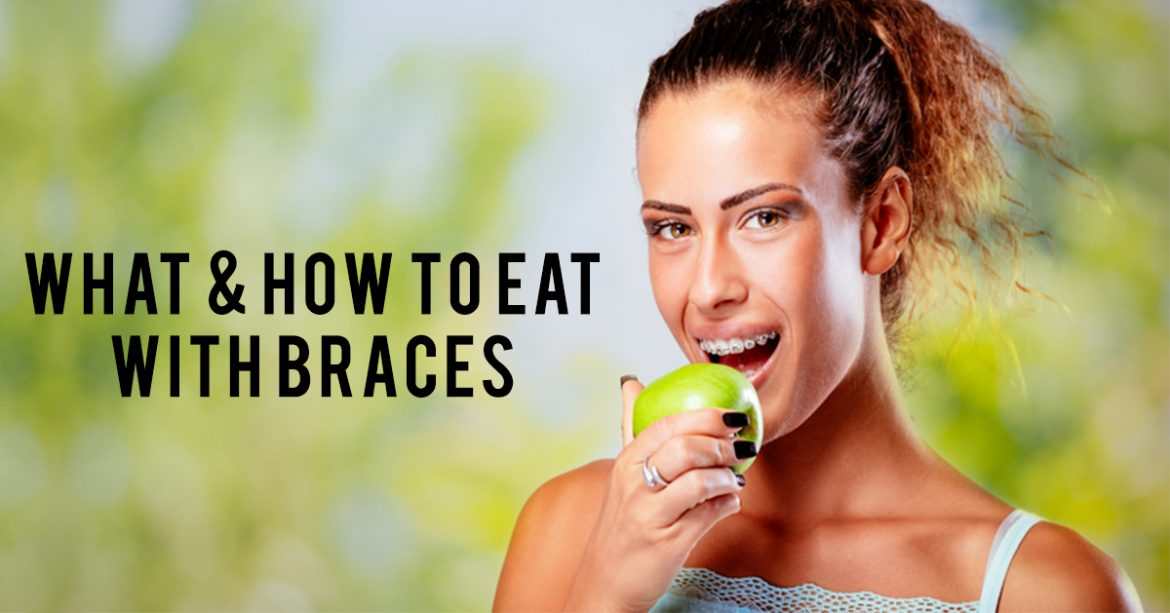Menu

If you recently got your braces, then the experience can undoubtedly be painful and difficult to deal with for the first few days. During this period, you may feel like the brackets are poking into your gums and cheeks, and have a tough time while chewing food.
You might even notice that your teeth don’t touch each other the same way. As a result, this changes the way you chew. For the first two to three weeks, your teeth will continue to shift, and you will have to adjust the way you chew accordingly.
While the pain may go away after a few days, it is extremely important to make conscious food choices. To help you manage the pain and learn how to eat with your new braces, here is our expert advice.
Change the Way You Eat
We are used to eating food in a certain way all our lives so, changing how you eat can become a challenge with new braces. To help you adjust during this crucial phase, we have the following tips:
Cut Food Into Small Pieces
To help you manage the amount of work your teeth have to do while eating, it is advisable to cut your food into small pieces. Make sure that you follow this practice even if you are eating soft, braces-friendly foods. This will prevent your brackets from coming off or breaking apart. In addition, this will reduce the pain and discomfort caused during eating.
Chew with Your Back Teeth
Eating is an unconscious process for the most of us, and we barely pay attention to which teeth we use to bite or chew our food. However, when you have braces, you need to be extra careful. Since your gums may be sore and teeth, sensitive in the first few weeks, you should use your back teeth for biting and chewing.
Back teeth are usually thicker and more suited for grinding food. This helps you alleviate the pain you experience in your front teeth. You should also ensure that you don’t tear or pull apart any food item. You can also use your fingers to put the food in your mouth if you are worried about accidentally biting the fork.
Eat Slowly
As mentioned earlier, eating is an unconscious process for most people. When you eat too quickly, it is easy to forget the extra care you have to take while eating with braces. What’s more, this may cause pain and inflammation since the bones and ligaments in your mouth are already weakened.
In addition, you could bite into hard substances such as seeds or bones while eating quickly. You can also drink plenty of water while eating to make swallowing easier. This will also help you rinse the food particles that may get caught in the braces.
Alter Your Diet
It is important to understand that getting braces is a long-term orthodontic treatment process. To make sure that it goes well, you will need to follow certain practices.
Pick Soft Foods
When you’re wearing braces, make it a point to include as much soft food in your diet as possible. In addition to being easier to eat, softer food is less likely to damage your braces or cause pain. Make sure that you steam vegetables till they are soft to consume. You can also eat foods like:
Avoid Hard Foods
Hard or crunchy foods are a big threat to your fresh new braces. They can cause cracks in them and even lead to pain during the first few weeks. Here are a few foods you should absolutely avoid:
Avoid Sticky Foods
Sticky foods run the risk of causing a lot of pain while chewing with new braces. Remove all sticky foods from your diet including:
Maintain Oral Hygiene
Brushing and flossing should be a part of your oral care routine with or without braces. However, when you have braces, they become all the more important. This is because braces give additional spaces for dental plaque to hide, posing a risk to your oral health as well as your orthodontic treatment.
Brush After Each Meal
The debris left behind after each meal can be painful for your tender gums and teeth. By brushing regularly, you can ensure that this debris is removed. Make sure to use a soft-bristled toothbrush to reduce it’s abrasive effect while cleaning. Like with eating, it is important to brush slowly as well.
You can also consider buying a toothbrush designed for people with braces like the Thermoseal Ortho to make brushing more effective.
Floss Everyday
You might notice that it is difficult to floss your teeth when you’re wearing braces. However, it is necessary to floss to remove the food and plaque caught between your teeth and around the braces.You can consider using Thermoseal Proxa Interdental Brushes and Younifloss Floss Picks to make interdental cleaning easier.
While getting your braces can prove to be a bit of an ordeal, if you follow the above-mentioned tips, you will be able to sport a perfect new smile soon. Remember, choosing how and what you eat can make all the difference. While the first few weeks will prove difficult, eating food will eventually become much easier. You can also check out our infographic on the topic here.


| PRODUCTS | QTY | PRICE | VALUE in INR |
|---|
| PRODUCTS | QTY | PRICE | VALUE in INR |
|---|